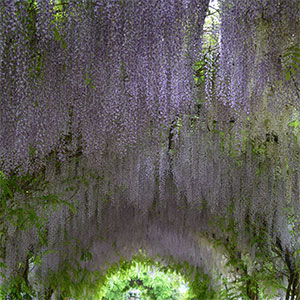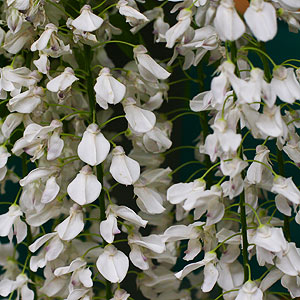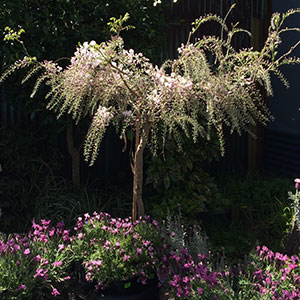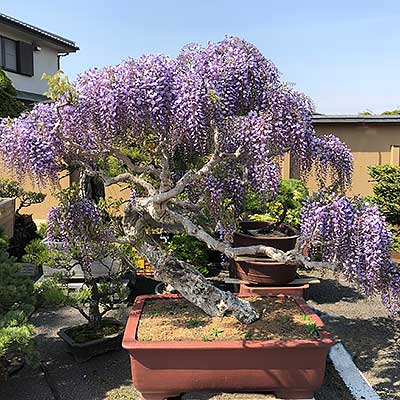
Wonderful flowering vines have cascades of beautiful fragrant flowers in spring and early summer.
The vines grow rapidly and require a very supportive structure to climb over. They need to be pruned to avoid becoming too heavy.
Wisteria are readily available for sale online. They are one of the best spring flowering climbing plants and include a number of varieties.
- American wisteria (Wisteria frutescens)
- Japanese wisteria ( Wisteria floribunda )
- Chinese wisteria ( Wisteria sinensis)
The American wisteria and the Kentucky wisteria (Wisteria macrostachya), are native to America and are good alternatives to the introduced species. They are not quite as aggressive in growth habit.
All are available from mail order nurseries and online suppliers.
Care

All wisteria varieties prefer a sunny position with a cool root zone and fertile, well-drained soil.
Wisteria makes a great climbing plant along a fence on an arbor or even left to scramble on the ground.
The fragrant blooms of these deciduous climbing plants are a real feature in spring.
USDA zones 4 – 9
Prepare for Planting
Choose a position where support will be available, fence, pergola or other.
Ensure the soil drains well.
How to Plant Wisteria
- Dig in some well-rotted compost before planting.
- Turn the soil and compost over for an area at least twice the size of the root ball. This will allow the root system to easily develop.
- Plant and firm in.
- Stake wisteria when planting; it allows the root system to settle in without moving around.
- Water in well with a liquid seaweed fertilizer.
- Mulch to maintain moisture and suppress weeds.
- Keep moist through the first summer.
Annual Care
- Mulch and fertilize in spring.
- Water during dry periods.
- Prune in late winter, remove 1/3 of last season’s growth, always pruning back to a strong bud.
- Cut back long runners to maintain size and improve flowering.
Growing Wisteria as a Tree or standard

Although mainly grown as a climbing vine these wonderful plants can also be purchased as a tree, or standard.
In fact any wisteria can be trained as a tree, or standard and it is a fairly simple process. And you can do this yourself.
Steps
- Select a young plant with upright growth and then plant with a strong supporting stake.
- Train up the stake until you reach the desired height, although we would be tempted to stop at no more than 6 feet as any higher tends to make them unstable.
- Once you have reached to desired height pinch out the leader to promote branching.
- You need to remove any suckers or lower growth on a regular basis.
- The top growth needs to be pruned each year to prevent the tree from becoming too top heavy.
So what we are actually doing is taking a plant that would naturally grow as a vine and standardizing it to grow as a small tree. And to make things more interesting, you can also grow wistwria as a bonsai.

Wisteria is very beautiful, fragrant and a wonderful symbol of spring.
Summary Information
- Botanical Name: Wisteria
- Common Name: Wisteria
- Family Name: Fabaceae
- USDA Zone: 4-9
- Height: 50 feet unpruned
- Spread: 16 feet
- Growth Rate: Medium to Fast
- Soil: Humus rich, moist and well drained
- Light: full sun to light shade.
- Container Growing: Yes
- Frost Tolerance: Light frosts only.
- Drought Tolerant: No
Where to buy
Wisteria Plants are available for sale from the following nurseries
BRUSHWOOD NURSERY
PO Box 483 Unionville, PA 19375 610-444-8083
Huge variety of clematis, passion flowers, climbing roses, jasmines and many other climbers.www.gardenvines.com
DIGGING DOG NURSERY
PO Box 471 Albion CA 95410 – phone (707) 937-1130
A spectacular selection of hard to find perennials, ornamental grasses, shrubs, trees and vines for your garden. Includes: Wisteria floribunda.www.diggingdog.com

